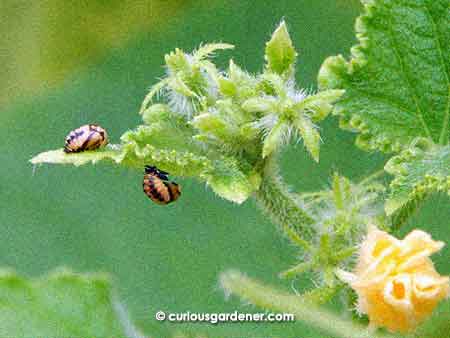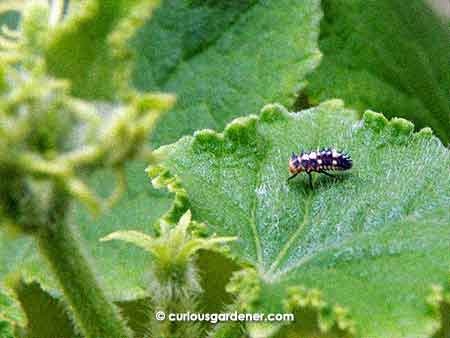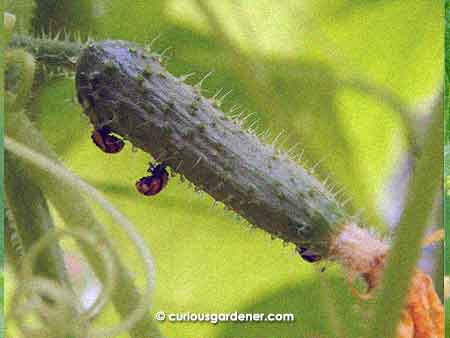The cucumber plants had been doing so nicely, and a few weeks ago, my heart dipped a bit when I noticed an unusual number of tiny ants spread across the surface of some leaves. Whenever we see ants on the plants, it usually signifies one thing – an infestation of aphids.
Aphids secrete a sugary liquid that attracts ants, and since the immature aphids are so small and difficult to spot, it’s usually easier to see ants running excitedly across the leaf surfaces when they find the aphids. I mean, hey, they’ve just discovered a nice sweet source of food, and knowing how rapidly aphids reproduce, it’s a jackpot to the ants.

These are ladybug cocoons. Don’t squish them! It’s the magical period when they develop from larvae to beetles.
In my earlier gardening days, my first reaction would have been to grab an appropriate insecticide and wipe out those colonies. However, that’s not a wise thing to do when you’re growing fruits and vegetables that you intend to eat. So my next step was to squish the colonies of aphids by hand. It wasn’t very pleasant, and I found that using a piece of tissue paper made that less unpleasant.
Then came the day when I was about to wreak havoc on the black aphids that were all over one of my prized winged bean plants when I noticed a little red ladybug scuttling along the stem of the plant. To my delight, I realised it was feeding on the aphids, and that began my quest to try to create a garden that ladybugs (not the 28-spotted one, though!) would come back to.
Here in Singapore, ladybugs have been scarce for several decades. For whatever reason, their natural habitat changed so much that they left. However, I’ve since learned that if you create the right environment for them, they will come back. In the case of yellow ladybugs, it’s plants – especially cucurbits – that have powdery mildew on their leaves that will attract them. In the case of red ladybugs, it’s colonies of aphids. This is why I tend to leave the aphids there now – unless they weaken the plants too much. Without a food source, there’s no reason for them to come by.
So, we got to observe the ladybugs going through their life cycle over a week or two – from larvae through metamorphosis, to adult beetles. The sad thing is, once they eat up all the aphids, they fly off elsewhere, and where that may be, I’ve not discovered yet. One day the cucumber plants had many red ladybugs wandering around the stems and leaves, and the next, there were none. I’m just glad they come when they’re needed.
© 2015 curiousgardener.com All rights reserved.



